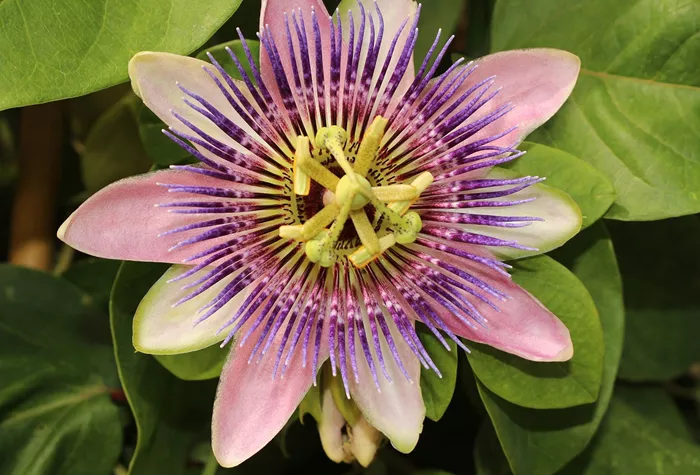Passion flowers are unique, exotic plants known for their striking appearance and fragrant blooms. They belong to the Passiflora genus, which includes over 500 species. Native to the Americas, they are highly sought after for both ornamental and medicinal purposes. Growing passion flowers can be a rewarding experience, but it requires some knowledge and care. In this guide, we will cover everything you need to know to grow and care for your passion flower plant.
Choosing the Right Passion Flower Variety
When deciding which passion flower variety to grow, it’s essential to choose one that suits your local climate. Some varieties thrive in tropical environments, while others can handle colder climates.
Passion flowers can be either vines or shrubs, with most varieties growing as climbing vines. Popular varieties include Passiflora caerulea (Blue Passion Flower), Passiflora edulis (Passion Fruit), and Passiflora incarnata (Purple Passion Flower). Each has unique features, but all are known for their large, intricate flowers.
Planting Passion Flowers
Planting your passion flower in the right location is crucial for its success. Passion flowers need a sunny spot with well-drained soil. They prefer areas with full sunlight for at least six hours a day. However, they can tolerate partial shade.
Step-by-Step Guide to Planting Passion Flower:
Step 1: Choose a sunny, sheltered location.
Step 2: Prepare the soil by ensuring it is loose and well-draining.
Step 3: Plant the seeds or young plants in the ground, about 3 to 5 feet apart if planting multiple vines.
Step 4: Water the plant well after planting and ensure it stays hydrated.
Caring for Passion Flowers
Once planted, passion flowers need consistent care to thrive. Regular watering, appropriate soil conditions, and careful pruning will ensure that your plant grows strong and healthy.
Watering: Passion flowers require a lot of water, but the soil should not be waterlogged. Ensure good drainage to avoid root rot.
Fertilizing: Fertilize your passion flower once a month with a balanced fertilizer to promote healthy growth and vibrant blooms.
Pruning: Trim dead or overgrown vines regularly to encourage new growth. Pruning helps the plant maintain a manageable size and promotes more flowers.
Supporting Passion Flower Vines
Since passion flowers are climbers, you will need to provide them with a support structure. This can be a trellis, fence, or another type of vertical structure. Training the vines to grow on these supports will help the plant flourish and make it easier to manage.
Best Support Options:
Trellis: Ideal for garden beds and patios.
Fences: Use an existing fence or set up a new one.
Arbors: Create a stunning focal point with an arbor designed for climbing plants.
Managing Pests and Diseases
Passion flowers are relatively hardy, but like all plants, they can fall victim to pests and diseases. Common pests include aphids, spider mites, and caterpillars. To keep your plant healthy:
- Inspect the plant regularly for signs of pests or diseases.
- Use insecticidal soap or organic pest control methods to treat infestations.
- Ensure the plant is not too stressed by overwatering or poor soil conditions.
Harvesting Passion Fruit
If you grow a fruit-bearing variety, such as Passiflora edulis, you will eventually harvest passion fruit. The fruit takes time to ripen, but once it’s mature, it will fall from the vine.
How to Harvest:
- Wait until the fruit turns yellow or purple, depending on the variety.
- Gently pick the fruit by twisting it off the vine.
- Let the fruit ripen indoors if needed, and then cut it open to enjoy the seeds and pulp.
Winter Care for Passion Flowers
If you live in a region with cold winters, you will need to take extra steps to protect your passion flowers from frost. Many passion flowers are hardy in USDA zones 6 to 9, but those in colder regions will require winter protection.
Container Growing: Growing passion flowers in containers allows you to bring them indoors during the winter months.
Mulching: Mulch the base of the plant to insulate the roots and protect them from the cold.
Cutting Back: If necessary, prune the plant back to encourage healthy growth come spring.
Troubleshooting Common Problems
While growing passion flowers is generally straightforward, you may encounter a few challenges. Below are some of the most common problems and how to address them.
Yellow Leaves: This can be caused by overwatering, poor drainage, or nutrient deficiencies. Ensure the plant is not sitting in soggy soil and consider fertilizing.
No Flowers: Passion flowers need full sunlight to bloom. If your plant isn’t flowering, it may not be getting enough light or may need more care.
Vine Damage: If your passion flower is getting damaged by wind or pests, reinforce its support structure or use organic pest control.
Conclusion
Growing passion flowers is a fulfilling and enjoyable gardening experience. With the right care, these unique and stunning plants will thrive and reward you with their beautiful blooms and, in some cases, delicious fruit. By following the steps in this guide, you can create the perfect environment for your passion flower to grow strong and healthy.
FAQs About Passion Flower
1. How long does it take for passion flowers to bloom?
Passion flowers typically bloom within 2 to 3 years from planting, though some varieties may take longer. Factors such as climate, care, and the specific variety can affect the blooming time.
2. Can passion flowers grow in pots?
Yes, passion flowers can grow in pots, especially if you live in a region with cold winters. Ensure the pot is large enough and has drainage holes to prevent waterlogging.
3. Do passion flowers need a lot of sun?
Yes, passion flowers thrive in full sunlight. They require at least six hours of direct sunlight per day for optimal growth and blooming.
4. How do you propagate passion flowers?
Passion flowers can be propagated through seeds, cuttings, or layering. For cuttings, take a healthy vine and root it in moist soil, ensuring it has access to indirect sunlight.


